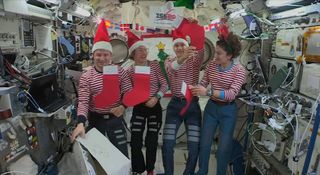
We'll apparently see one more big private spaceflight milestone before 2020 is done.
In May, SpaceX became the first company ever to launch astronauts to the International Space Station (ISS). That mission, a test flight known as Demo-2, sent NASA's Bob Behnken and Doug Hurley to the orbiting lab for a two-month stay.
Then, last month, Elon Musk's company launched Crew-1, its first operational astronaut mission to the station under a $2.6 billion contract with NASA's Commercial Crew Program. Crew-1 carried four spaceflyers — NASA's Victor Glover, Mike Hopkins and Shannon Walker and Japan's Soichi Noguchi — to the ISS for a regular six-month stint.
Those successes helped pave the way for one more commercial crew flight to the station this year, and a very special one at that: The U.S. Federal Aviation Administration (FAA) announced on Wednesday (Dec. 23) that it has, "for the first time ever," issued a special commercial space license to Santa Claus for a crewed mission to the ISS.
Related: Holidays in space: an astronaut photo album
Santa won't be flying on SpaceX's Crew Dragon capsule, however. St. Nick will travel aboard "his StarSleigh-1 space capsule powered by the Rudolph Rocket," FAA officials wrote in a statement. "The mission license includes both launch and reentry operations and will occur from a U.S.-based spaceport."
That spaceport isn't specified. But the Pacific Spaceport Complex in Alaska, which recently hosted the California startup Astra's first spaceflight, would be a natural choice, given its relative proximity to the North Pole.
Get the Space.com Newsletter
Breaking space news, the latest updates on rocket launches, skywatching events and more!
Santa has obviously visited the ISS before; otherwise, Christmas-celebrating astronauts on the orbiting lab would not have received any presents. But how he made those previous trips is unclear, since the newly issued license is the first commercial one that the FAA has given to Santa.
For example, has StarSleigh-1 — a mysterious craft about which little is known — flown to the station surreptitiously in previous years? Santa is obviously in possession of very advanced technology, so it's possible the capsule features some sort of cloaking system. And unlicensed visits to the ISS would certainly not be out of character for St. Nick, history's most skilled and accomplished home invader.
Or perhaps Santa used to stow away aboard NASA's space shuttles and Russian Soyuz spacecraft, the only crewed vehicles that had ever visited the ISS prior to Crew Dragon's pioneering missions this year. (The shuttles were grounded in 2011, so the Soyuz was until recently the only orbital astronaut taxi available.) Portly though he may be, Santa can slide down the narrowest of chimneys, so squeezing unnoticed into the three-person Soyuz isn't out of the question.
Most of Santa's present-delivering time this Christmas Eve, of course, will be spent here on Earth. As always, you can track the jolly elf's progress around our planet via NORAD, the North American Aerospace Defense Command.
Mike Wall is the author of "Out There" (Grand Central Publishing, 2018; illustrated by Karl Tate), a book about the search for alien life. Follow him on Twitter @michaeldwall. Follow us on Twitter @Spacedotcom or Facebook.
Join our Space Forums to keep talking space on the latest missions, night sky and more! And if you have a news tip, correction or comment, let us know at: community@space.com.

Michael Wall is a Senior Space Writer with Space.com and joined the team in 2010. He primarily covers exoplanets, spaceflight and military space, but has been known to dabble in the space art beat. His book about the search for alien life, "Out There," was published on Nov. 13, 2018. Before becoming a science writer, Michael worked as a herpetologist and wildlife biologist. He has a Ph.D. in evolutionary biology from the University of Sydney, Australia, a bachelor's degree from the University of Arizona, and a graduate certificate in science writing from the University of California, Santa Cruz. To find out what his latest project is, you can follow Michael on Twitter.
